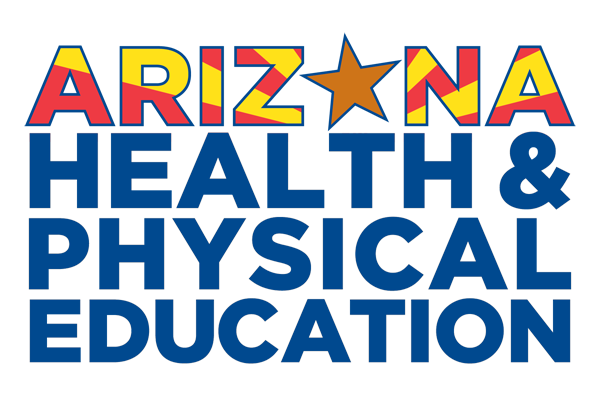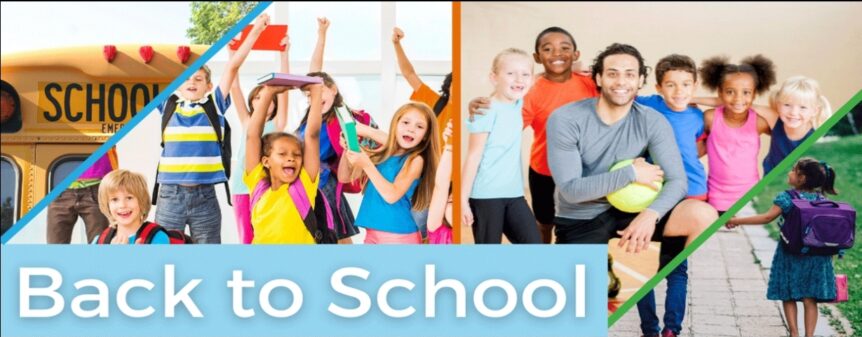Greetings Arizona Health and Physical Educators!
Hard to believe that a short 6 or 8 weeks ago, we were counting down to the END of the school year, and now here we are getting ready for another round of “meet the teacher” night! I don’t know about you but summer always provides me with just a taste of what my retirement schedule might look like, and I’m diggin’ it!
But I digress, it’s time to get ourselves ready for those early morning duties, after school meetings, sports practices and lesson planning! The beginning of the school year is always a time of anticipation and excitement about what we are going to teach, maybe unpacking new equipment, meeting new students and figuring out the ‘specials’ schedule.
Being an adapted physical educator, the first couple weeks of school for us is all about trying to figure out which schools we will be covering, who the physical education teachers are at that school and what the PE schedule will be for the kids on our caseload. Once we get that figured out, we then focus on providing modifications, adaptations and modifications for activities that will help our PE teachers provide an inclusive teaching environment. Simple right?
Now imagine this: first day of class and you are going over some of your rules and procedures. All of a sudden, a student starts running around, flailing her arms, making a screeching sound. You approach the student (you haven’t learned their names just yet) and try to explain that her behavior is inappropriate. The student doesn’t seem to understand or even hear you and begins to rock back and forth while continuing to make the screeching sound.
Now imagine you are a student standing in the same gym and your clothes are itchy and feel heavy on your body; you hear the other children talking, yelling, their voices are echoing and their sneakers are screeching on the gym floor; basketballs are bouncing, the fluorescent lights are buzzing, cones and other pieces equipment are scattered everywhere and your head feels as if it’s going to explode! Welcome to physical education class for a student with Autism.
Autism can be a puzzling disability with an unknown etiology and it affects each individual differently and in varying degrees (Fittipaldi-Wert & Mowling, 2009). The physical environment is constantly changing (organization, activity, equipment) and for a student with Autism, this can be overwhelmingly chaotic. Individuals with Autism tend to have characteristics that include deficits in social interaction and communication, repetitive behaviors (rocking back and forth), desire sameness or routine, and may have difficulty understanding spoken language (Fittipaldi-Wert & Mowling, 2009). Individuals with Autism also tend to be visual learners, processing visual information (pictures, written words) more effectively than auditory input (listening to the teacher talk about rules and procedures).
How can we as physical educators support our students with Autism (or other intellectual disabilities)? What teaching strategies can we use to help our students enjoy physical education class? Simply put, visuals! And we’ve all used visuals in some form before. If you have a bulletin board in your gym or locker room, if you’ve used signs during a fitness activity or game, if you’ve used a scoreboard, you’ve used visuals. For students with Autism, visual supports can provide a predictable schedule of events, promote independent transitions, or provide visual explanations of a skill or activity. Visual supports can help create predictability and consistency which helps students with Autism navigate their world.
This blog will hopefully provide you with some resources you can use to help your students with Autism successfully participate in your physical education class, including PECS, or the Picture Exchange Communication System, activity schedules, ‘First-Then’ charts, and Token Reward Charts.
PECS are groups of cards with drawings of objects or skills along with the word for that object or skill written above the drawing. PECS can be used on a ring or lanyard, in a binder or an individual page (see below). Typically created using Boardmaker® but you can also use google images or even real pictures and drawings.
PECS Ring (can also be on a lanyard)
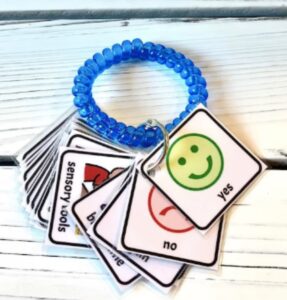
PECS Binder (which might be the child’s whole communication system, not just words for PE or behaviors).
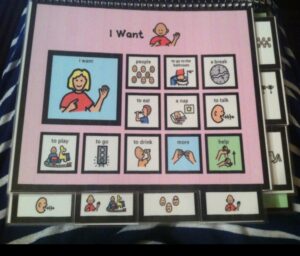
PECS Page
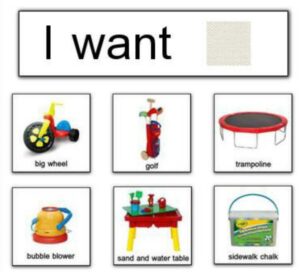
Activity Schedules, which are just the PECS cards and pictures placed in the order of events for the day. These schedules can be created using a white board (or cardboard, or clipboard) and Velcro® (the PE teacher’s best friend!), along with the PECS pictures. Students can pull the activity card off the schedule under the ‘to do’ column and place it in the ‘done’ column when the task is completed. This also allows the student a visual of what is coming up next (see below for an example).
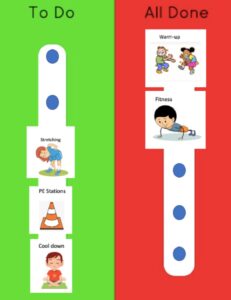
You can use long strips of Velcro and dots of Velcro® on the back of each picture, or all dots or whatever you want. The beauty of combining PECS with these visual schedules is that you can change the pictures each day or even each class period if you want to use the chart for different students.
‘First-Then’ Charts
A First-Then chart is a visual display of something the student prefers that will happen after completing a task that is less or non-preferred (in PE lingo we call this the Premack Principle, and in parent language we call it bribery 😉). The First-Then chart can motivate students to do activities they don’t necessarily like and clarifies when they can do what they like. These charts can also help lay the language foundation needed to complete multi-step directions. I like to find out the student’s favorite activity, for example bouncing on the exercise ball. After they complete a set of push-ups, they get to bounce for 30 seconds. So first work, then fun!
Token Reward Charts
Token economy systems (e.g. sticker/reward charts, points systems) are extremely effective tools and a behavior management strategy.These charts can provide positive reinforcement, teach appropriate behavior and minimize challenging behavior. My strategy is to use little pictures of stars or check marks along with a picture of the ‘reward’. I put Velcro® dots on the back of each picture, on the back of this chart and in each box on the front of this card. Whenever a student completes a task, whether it be working for 2 minutes, one set of push-ups, following a one-step direction, whatever, they get to move one of the stars from the back of the card to the front. Once they earn four stars, they also then earn the BIG reward, whether it is computer time in the classroom, a sticker, whatever motivates that student.
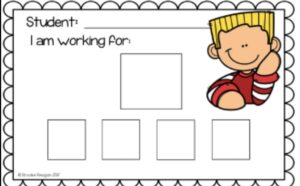
So there ya have it! Just a few simple strategies to make your classroom a more inclusive and enjoyable learning environment for your students with Autism or other intellectual disabilities. I hope you find these suggestions helpful and if you would like to share your success stories, I’d LOVE to hear them! Also, if you have any questions or need help creating some useful visuals, just reach out to me, Jennifer Houston at [email protected], or your local adapted PE teacher.
Lastly, remember to mark your calendar for your annual Arizona Health and Physical Education Convention, happening October 25th – 27th at the Phoenix Convention Center. This year we are combining the State convention with the Adapted PE conference so we hope to see ALL physical educators there! Here is the link for more information: https://www.azhpe.org/state/
THANKS FOR READING AND HAVE A GREAT FIRST QUARTER!
References
Fittipaldi-Wert, J., & Mowling, C. M. (2009). Using visual supports for students with autism in physical education. Journal of Physical Education, Recreation & Dance,
